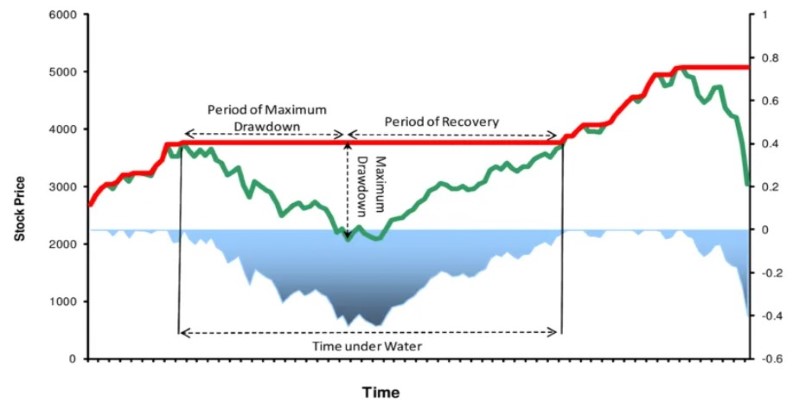Understanding risk is essential when it comes to investing. While many investors focus on returns, the risks you face can have an equally significant impact on your portfolio's success. One vital measure of risk is the Maximum Drawdown (MDD). This metric gives investors insight into the worst possible scenario of a portfolio's performance by assessing the most significant peak-to-trough decline within a specific period.

Grasping MDD can not only protect your investments but also enhance your decision-making processes. This article will dive into the concept of Maximum Drawdown, explaining how it works, how it's calculated, and why it matters for investors.
Maximum Drawdown (MDD) is a measure used to evaluate the maximum observed loss from a peak to a trough in an investment portfolio over a particular period. Unlike metrics that focus on average returns, MDD specifically highlights the potential risk of substantial losses. The drawdown is expressed as a percentage and offers insight into how much your portfolio could potentially decline during unfavorable market conditions.
MDD is not about short-term fluctuations or temporary dips; it focuses on the most severe sustained loss within a given timeframe. For instance, if your investment reached a peak of $100,000 and then dropped to $70,000 before rebounding, the MDD would be 30%, reflecting the deepest fall during that period.
For investors, especially those concerned with long-term performance and risk management, MDD is an essential metric. Knowing the MDD of a portfolio allows you to understand the worst-case scenario you might face. This knowledge is particularly useful when comparing different investments or strategies, as it gives you a clearer picture of their risk profiles. MDD is critical for:
Assessing Portfolio Risk: MDD provides an unfiltered look at the worst decline your portfolio could face, offering a clear measure of risk.
Comparing Investment Strategies: When evaluating multiple strategies or funds, MDD can serve as a comparison tool, highlighting which approaches expose you to more significant losses.
Informed Decision-Making: Armed with MDD data, investors can align their risk tolerance with their investment choices, ensuring that they dont take on more risk than theyre comfortable with.
Maximum Drawdown (MDD) measures the largest percentage drop in value from a portfolios peak to its lowest point over a given period. It highlights the most significant decline an investment or portfolio experiences before starting to recover. Calculating MDD is straightforward but involves understanding the relationship between the peak and trough of your portfolio during a specified timeframe.
MDD= (Trough Value Peak Value/ Peak Value) 100
This formula determines the percentage drop from the highest value (the peak) to the lowest value (the trough) within the period under analysis.
Identify the Peak Value: First, determine the maximum value (or highest point) your investment reached during the analysis period. This is known as the peak.
Identify the Trough Value: Next, find the minimum value (or lowest point) your investment fell to after reaching the peak. This is known as the trough.
Calculate the Difference: Subtract the trough value from the peak value. This difference represents the total loss during the downturn.

Divide by the Peak Value: To express the drawdown as a percentage, divide the difference by the peak value.
Multiply by 100: The final step is to multiply the result by 100 to convert it into a percentage.
If you plot the value of your portfolio over time on a graph, the drawdown represents the steepest decline from the highest peak to the lowest trough. The MDD will be the deepest point in the drawdown curve, where the distance between the peak and trough is most pronounced.
While MDD measures the severity of a loss, it doesnt account for the time it takes to recover. Even if a portfolio has a high MDD, its essential to consider how long it remains in a drawdown state before returning to its peak. The longer the recovery time, the more severe the impact of that drawdown.
Various factors can influence the Maximum Drawdown (MDD) of a portfolio, determining the extent of potential losses during adverse market conditions. Here are some key aspects that contribute to MDD:
Market volatility is a primary driver of MDD. Highly volatile markets experience sharp and sudden price movements, leading to more significant declines in portfolio value. When markets are turbulent, the risk of substantial drawdowns increases, resulting in higher MDD.

The investment strategy adopted plays a significant role in influencing MDD. Aggressive strategies that focus on high-growth assets, such as technology stocks or emerging markets, often face larger drawdowns during downturns. While these strategies aim for higher returns, they come with increased risk, leading to deeper MDDs during challenging periods.
The way a portfolio is diversified impacts its drawdown levels. Portfolios with a diversified asset allocationspanning across different asset classes like stocks, bonds, and real estatetypically show lower MDDs. This is because the risk is spread out, reducing the impact of any single asset class underperforming during a downturn. A well-diversified portfolio helps cushion against significant losses, keeping MDD in check.
Maximum Drawdown (MDD) is an indispensable tool for any investor focused on managing risk. By understanding MDD, how it is calculated, and how it fits into broader risk management strategies, investors can make more informed decisions.
Although MDD has its limitations, when used alongside other risk metrics, it can provide a comprehensive view of your portfolios risk profile. With this knowledge, investors can better prepare for market downturns, avoid unnecessary losses, and ultimately stay on track to achieve their financial goals.

By Sid Leonard/Aug 27, 2024

By Gabrielle Bennett /Sep 02, 2024

By Verna Wesley/Sep 03, 2024

By Elva Flynn/Sep 03, 2024

By Vicky Louisa/Aug 27, 2024

By Maurice Oliver/Aug 31, 2024

By Tessa Rodriguez/Sep 04, 2024

By Alison Perry/Aug 27, 2024

By Triston Martin/Aug 26, 2024

By Verna Wesley/Aug 26, 2024

By Juliana Daniel/Sep 04, 2024

By Georgia Vincent/Aug 28, 2024